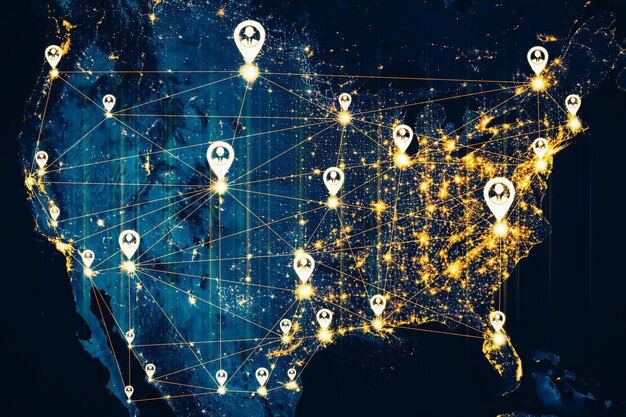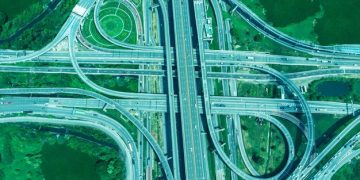Remote Work’s Long-Term Impact on US Communities Explained

The widespread adoption of remote work has profoundly reshaped the economic, social, and demographic landscapes of US communities, catalyzing shifts in urban centers, rural growth, and local economies.
The landscape of work has undergone a seismic shift, particularly in the United States, propelled by technological advancements and accelerated by global events. The concept of working from anywhere, once a niche perk, has rapidly evolved into a mainstream reality, prompting a critical examination of the impact of remote work on US communities: what are the long-term effects? This question delves far beyond mere logistical changes, touching upon the very fabric of local economies, social structures, and demographic trends across the nation.
The Great Dispersion: Reshaping Metropolitan and Rural Demographics
The rise of remote work has fundamentally altered traditional migration patterns within the US, leading to a notable “great dispersion” of populations. This phenomenon sees individuals and families reconsidering the necessity of residing in expensive, densely populated urban centers, opting instead for locations that offer a better quality of life, lower cost of living, and greater access to nature.
Migration Trends and Their Drivers
Remote work has untethered many from physical offices, allowing them to pursue aspirations beyond urban confines. This newfound mobility contributes to a significant demographic redistribution.
- Exodus from Major Metros: High-cost cities like San Francisco, New York, and Los Angeles have experienced varying degrees of outward migration, particularly among knowledge workers.
- Growth in Mid-Sized Cities: Cities such as Austin, Boise, and Raleigh have seen an influx of new residents, drawn by a blend of urban amenities and more affordable living.
- Rural Renaissance: Some rural areas, particularly those with good internet infrastructure and access to outdoor recreation, have witnessed unexpected population growth.
This shift isn’t uniform, but the general trend points towards a decentralization of the workforce, with profound implications for both the communities left behind and those newly populated. The drivers are clear: enhanced affordability, reduced commute times, better work-life balance, and a desire for more spacious living environments. This has, in turn, placed new pressures on the infrastructure and services of receiving communities. The balancing act between welcoming new residents and maintaining local character is becoming a critical challenge for many growing areas.
The long-term effects of this dispersion are multifaceted. While some urban areas grapple with declining tax bases and commercial vacancies, former “bedroom communities” and burgeoning smaller cities face demands for increased public services, housing, and infrastructure. Understanding these shifts is crucial for urban planners and local governments as they adapt to a dynamically changing populace. The ability of communities to absorb this growth gracefully, without losing their core identity, will be a defining aspect of the remote work era.
Economic Restructuring: New Challenges and Opportunities for Local Economies
The economic ripple effects of remote work are extensive, touching everything from local tax revenues to the viability of small businesses. As spending patterns change and populations migrate, communities must adapt their economic strategies to thrive in this new environment. The traditional reliance on downtown office economies is diminishing, prompting a necessary pivot towards diversified local ecosystems.
Impact on Local Businesses and Tax Bases
Remote work reshapes consumer behavior. While some local businesses might benefit from new residents, others, particularly those catering to the daily office commuter, face significant headwinds.
- Decline in Downtown Commerce: Restaurants, cafes, and retail stores dependent on office worker traffic in central business districts have experienced reduced footfall and revenue.
- Boom in Suburban and Rural Services: Conversely, businesses in residential areas, from grocery stores to local service providers, may see an uptick in demand as more people spend their workdays at home.
- Property Tax Implications: Commercial property values in dense urban centers could decline, potentially impacting municipal tax revenues that fund essential public services.
These shifts necessitate a reevaluation of economic development strategies. Local governments might need to explore new revenue streams, incentivize diverse business creation, and invest in infrastructure that supports a distributed workforce, such as high-speed internet. The long-term economic stability of communities will hinge on their ability to pivot from commuter-centric models to more diversified, resident-focused economies. This includes supporting local entrepreneurship and fostering services that cater to a home-based workforce, from co-working spaces to health and wellness facilities. The adaptability of the local business community will be paramount for sustained economic vitality.
Infrastructure and Public Services: Strains and Necessary Adaptations
The sudden and sustained shift to remote work has placed unprecedented demands on existing infrastructure and public services, particularly in areas experiencing population growth. From digital connectivity to public transportation, communities are scrambling to catch up. This pressure highlights the need for significant investment and strategic planning to ensure that basic necessities and modern comforts are available to all residents.
Broadband Access and Public Transportation
The digital divide has become even more apparent with remote work. Reliable, high-speed internet is no longer a luxury but a fundamental utility for participation in the modern economy.
- Broadband Expansion: Rural and underserved areas, often lacking robust internet infrastructure, are now critical bottlenecks. Federal and state initiatives to expand broadband access are more urgent than ever.
- Rethinking Transportation: With fewer people commuting to central offices, public transportation systems face ridership declines and reduced revenue. This prompts questions about the future of urban transit and investment priorities.
- Housing and Utilities: Growing communities face increased pressure on housing markets, leading to affordability crises in some areas. Utilities such as water, electricity, and waste management also experience increased demand.
Local governments are forced to re-evaluate their investment priorities. Resources once allocated to expanding commuter rail lines might now be redirected towards improving local road networks, upgrading water treatment facilities, or subsidizing high-speed internet development. The challenge lies in anticipating these needs and allocating resources effectively, often with limited budgets. The success of a remote-work community will largely depend on its ability to provide the foundational services and infrastructure that support a distributed population, ensuring equitable access and sustainable growth.

Social Cohesion and Community Identity: Redefining Belonging
The physical proximity of work often fostered informal community ties. With remote work, these connections are weakening, prompting a re-evaluation of how social cohesion and community identity are built and maintained. The challenge lies in creating meaningful shared experiences when daily routines are largely home-based and interactions are increasingly digital.
The Fabric of Local Life
Remote work impacts informal gathering places and the sense of common purpose within a community.
- Decline of Traditional Social Hubs: Office buildings, downtown lunch spots, and after-work happy hour locations traditionally served as social anchors. Their diminished role requires new avenues for connection.
- Rise of Hyper-Localism: As people spend more time in their neighborhoods, local parks, community centers, and smaller, neighborhood-specific businesses may see increased utilization, fostering a more hyper-local sense of community.
- Challenges for Civic Engagement: Without daily physical interaction, recruiting volunteers for local events, participating in civic groups, or engaging in local politics might become more challenging.
Communities are exploring innovative ways to foster connection, from encouraging local events and farmers’ markets to investing in public spaces where people can gather casually. The long-term impact hinges on whether communities can intentionally cultivate social bonds that transcend traditional workplace interactions. This requires proactive efforts from local leaders, community organizations, and residents themselves, ensuring that remote work doesn’t lead to social isolation but rather to new, more decentralized forms of community. Redefining what it means to “belong” to a local area in an increasingly virtual world is a key challenge that many communities are now confronting.
Environmental Implications: A Mixed Bag of Outcomes
The environmental impact of remote work presents a complex picture, with both potential benefits and unforeseen challenges. From reduced commuting emissions to changes in energy consumption, the ecological footprint of communities is being redefined. It’s not a simple equation, as the overall effect depends on a multitude of factors, including energy sources and lifestyle choices.
Transportation and Energy Consumption
While the decrease in daily commutes is often cited as a clear environmental benefit, other factors must be considered.
- Reduced Commuting Emissions: Fewer cars on the road mean lower greenhouse gas emissions and less traffic congestion, contributing to cleaner air in urban areas.
- Increased Home Energy Use: More people working from home translates to increased residential energy consumption for heating, cooling, and powering electronics. The environmental impact depends on the source of this energy.
- Suburban Sprawl and Longer Non-Commute Trips: The dispersion of populations might lead to increased suburbanization, potentially resulting in longer car trips for leisure, errands, or social visits, offsetting some of the commuting gains.
The net environmental effect of remote work remains subject to ongoing study. While a reduction in daily office commutes is a positive step, the increase in home energy consumption and potential for increased car usage for non-work-related activities complicates the overall picture. Encouraging energy-efficient homes, promoting renewable energy sources, and developing walkable or bikeable communities will be crucial for maximizing the environmental benefits of a remote workforce. Local planning and individual choices will both play significant roles in shaping the future ecological imprint of remote-work communities.
Policy and Planning: Adapting Governance for a Remote-First World
Faced with the profound and multifaceted impacts of remote work, local and federal governments are compelled to rethink existing policies and planning frameworks. The traditional models of urban development, taxation, and public service provision were largely designed for a commuting workforce and centralized office economies. A remote-first world demands a nimble and responsive approach to governance.
New Policy Imperatives
Governments must develop strategies that address the challenges and leverage the opportunities presented by remote work.
- Flexible Zoning Laws: Traditional zoning often separates residential and commercial areas. Remote work necessitates more flexible zoning that allows for mixed-use developments and home-based businesses.
- Broadband as a Public Utility: Policies must increasingly treat high-speed internet as an essential utility, akin to water or electricity, with public funding and oversight for equitable access.
- Support for Revitalizing Downtowns: Strategies to repurpose vacant commercial spaces into residential units, mixed-use developments, or community hubs can help prevent urban decay and diversify economic activity.
- Investing in “15-Minute Cities”: The concept of a “15-minute city,” where essential services are accessible within a short walk or bike ride, becomes more relevant as people spend more time in their local neighborhoods.
Policy makers are grappling with questions of fair taxation for remote workers, especially those living in one jurisdiction and working for a company based in another. There’s also a growing need for enhanced digital literacy programs and support systems for workers transitioning to remote roles, ensuring no one is left behind. The evolution of policy will be critical in shaping resilient and adaptable communities that can flourish in the remote work era. This requires forward-thinking leadership that prioritizes long-term community well-being over short-sighted fixes. Communities that proactively integrate remote work into their strategic planning will be better positioned for sustainable growth and enhanced quality of life for their residents.
The proactive development of policies that address the challenges posed by remote work, while simultaneously harnessing its potential benefits, is paramount. This includes innovative approaches to funding public services in areas experiencing rapid growth and adapting regulatory frameworks to support new forms of business and living. The long-term success of communities will depend heavily on their ability to create governance structures that are agile and forward-looking, capable of responding to the evolving demands of a distributed workforce and population. Transparency and community involvement in these policy discussions will be vital for ensuring broad public acceptance and effective implementation.
New models of governance, perhaps involving greater collaboration between municipal and regional authorities, will also be essential. The fluidity of population movement means that issues previously confined to single jurisdictions may now have broader regional implications. This calls for a more integrated approach to services like transportation and environmental management. Ultimately, the policy and planning decisions made today will determine the long-term viability and attractiveness of communities in a world increasingly defined by flexibility and decentralization. The opportunity exists to build stronger, more equitable, and more sustainable communities if leaders embrace the necessary transformations.
| Key Aspect | Brief Description |
|---|---|
| 🏡 Demographic Shift | Population moves from major cities to suburbs and rural areas, decentralizing the workforce. |
| 💰 Economic Rebalancing | Challenges for downtown businesses vs. growth in residential area services. |
| 🌐 Infrastructure Strain | Increased demand for broadband and utilities, changes in public transit use. |
| 🤝 Community Dynamics | Redefining social cohesion as interactions shift from office to local neighborhoods. |
Frequently Asked Questions About Remote Work’s Community Impact
While some major US cities have seen population outflows, a complete decline is unlikely. Cities are adapting by repurposing commercial spaces, incentivizing mixed-use developments, and focusing on quality of life improvements to remain attractive. The shift is more about transformation than total abandonment, as cities continue to offer unique cultural and economic advantages.
Remote work can intensify housing affordability issues in communities experiencing an influx of new residents. As demand rises, home prices and rents often increase, potentially displacing long-time residents or making it difficult for essential workers to afford to live in the area, creating significant socio-economic challenges for local governments.
The primary challenge for rural areas is often the lack of robust high-speed internet infrastructure, which is essential for remote work. Other challenges include limited access to specialized healthcare, fewer educational opportunities, and differing cultural amenities compared to urban centers, requiring significant investment and strategic planning to overcome these hurdles.
Potentially yes, mainly through reduced commuting emissions and less traffic congestion. However, increased home energy consumption and potentially more localized driving trips for non-work activities can offset these gains. True improvement depends on widespread adoption of renewable energy, energy-efficient homes, and thoughtful urban planning that promotes local amenities and reduces the need for extensive travel.
Many local governments are in the early stages of adapting to these long-term impacts. Challenges include revenue shifts from property taxes, increased demand for services in growing areas, and the need for updated infrastructure. Proactive planning, flexible policies, and collaboration across jurisdictions are crucial for effectively navigating these complex socio-economic and demographic transformations.
Conclusion
The long-term effects of remote work on US communities are far-reaching and multifaceted, signaling a fundamental realignment of how and where people live and work. From shifting demographic patterns and economic restructuring to increased demands on infrastructure and evolving social dynamics, every aspect of community life is being influenced. While challenges such as housing affordability and infrastructure gaps persist, there are also immense opportunities for growth, revitalization, and the creation of more resilient, distributed communities. The ability of local governments, businesses, and residents to adapt proactively, invest in critical infrastructure, and foster new forms of social cohesion will ultimately determine the success and sustainability of US communities in this new remote-first era. The future promises a diverse tapestry of vibrant localities, each finding its unique path in a world defined by evolving work paradigms.





